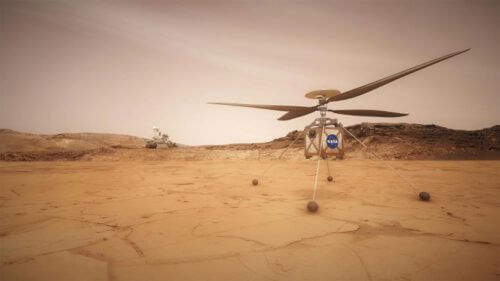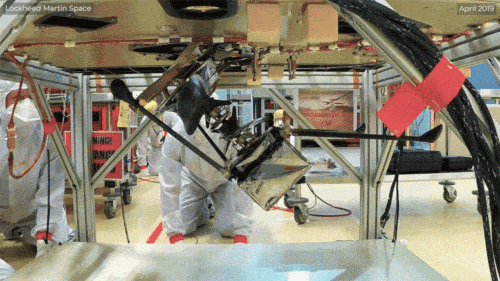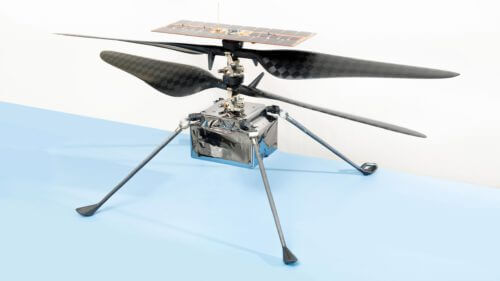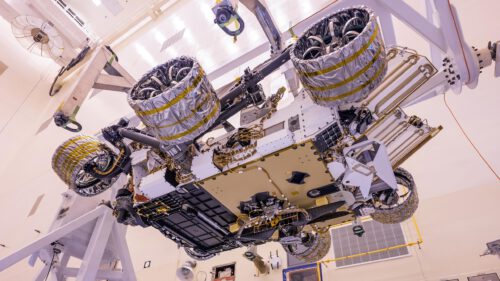The small craft will try to prove that controlled powered flight is possible on another planet. But just to bring it to the land of Mars will require a lot of ingenuity

NASA's Mars Ingenuity ("Ingenuity") helicopter will travel with the Perseverance vehicle a distance of 505 million km in interstellar space to reach Mars. But for the team working on the first experimental test flight on another planet, planning the last 13 cm of the journey was among the most challenging tasks. To safely make it 13 cm - the distance Ingenuity will travel from where it is stored in the vehicle to the Martian soil - they developed the sophisticated extraction system of the Mars helicopter.
"Ingenuity is unlike any other helicopter ever built because controlled powered flight on Mars is unlike anything else that has ever been attempted," said Mimi Ong, director of the Mars Helicopter Project at NASA's Jet Propulsion Laboratory (JPL) in Southern California. "Then we had to think about how to catch a ride and deploy safely from the Perseverance vehicle of Mars 2020."

The square body of Ingenuity (which stores computers, cameras, batteries, etc.) is about the size of a softball (20 x 16 x 14 cm). But if you look outside the box, you find a lot of other interesting things—including an antenna, solar panel, landing legs, and two 1.2-meter-long rotors—all of which make storing and deploying the helicopter a challenge. The weight of the whole package is about 2 kg.
"On a Mars rover mission, the addition of even one new puck is usually worth a discussion," said Chris Salvo, director of the Mars 2020 mission's helicopter interface at JPL. "The Mars Ingenuity helicopter is a large, fragile and unique collection of equipment unlike anything NASA has handled on an interstellar mission."
NASA's Ingenuity helicopter travels to Mars attached to the belly of the Perseverance vehicle and must safely detach to begin the first attempt at powered flight on another planet. Experiments carried out at NASA's Jet Propulsion Laboratory and at Lockheed Martin Space show the sequence of events that will bring the helicopter down to the Martian soil. Credit: ASA/JPL-Caltech and Lockheed Martin Space
Mission engineers considered every parking space available on the vehicle's mount for their unusual addition, including the robotic arm. They ended up nesting on the belly of Presbyrans, which over a relatively flat section of the Red Planet's soil would allow a clearance of about 67 cm from the ground. This may seem like a lot of space (a national SUV has about a third of that), but the exhaust system reduces this distance by about 6 cm. Ingenuity's height is about 48 cm. This is where the 13 cm journey comes into play.
"It's not a lot of room to maneuver," Salvo said, "but we found that if you attach the helicopter horizontally, there's enough room to get the job done."
How the work is done
Ingenuity will be deployed approximately two months after Providence lands on February 18, 2021. During the first operations on the ground, the vehicle and helicopter crews will search for possible airfields—a ten-by-ten-meter piece of land that is relatively flat, balanced, free of obstacles, and accessible For viewing by Presbyrans when the vehicle is parked up to several hundred meters away.
Around the 60th Sol day of the mission, Perseverance will remove the composite graphite shield of the Mars copter's ejection system that protected the copter during landing. He will then travel to the center of the selected airport. About six days later, after the crews of the vehicle and the helicopter are satisfied that everything is in order, they will send a command to the extraction system of the Mars helicopter to do its job.

The deployment process begins with the release of a locking mechanism that holds the helicopter in place. A pyrotechnic cable-cutting device is then activated, allowing the spring arm that holds the helicopter to begin rotating Ingenuity out of its horizontal position. Along the way, a small electric motor will pull the arm until it locks, bringing the helicopter body to a fully vertical position with its two spring landing legs deployed. Another pyrotechnic device is activated, releasing the other legs.
"And during that time, the deployment system has to maintain the electrical and data cable connections between the vehicle and the helicopter until it's ready for descent," said David Butcher, manager of the deployment system at Lockheed Martin Space in Denver, which built the system. "I worked on a lot of deployment systems in space, but this was a different level."
If all goes well, the mission controllers will give the ejection system a command to release, and Ingenuity will make it through those last 13 cm. After a good landing is confirmed, Presbyrans will be ordered to move away so the helicopter can begin recharging its batteries using the solar panel. At this point the 30-sol clock of Ingenuity's test flight program starts ticking.

The Mars Ingenuity helicopter is an experimental test flight of new technology. Future Mars missions could employ second-generation helicopters to add an aerial dimension to their exploration. They would be able to act as scouts for the human crew, carrying small sledgehammers or exploring cliffs, caves, deep craters and other unvisited or hard-to-reach destinations. But before any of that happens, an experimental helicopter must prove it's possible.
And before the test copter can do any of these things, it has to land safely on the surface of Mars.
"Ingenuity needs perseverance," Ong said. "The launch system of the Mars helicopter is a sophisticated tool and just one of the examples of how the Mars 2020 mission worked above and beyond the requirement to enable our experimental project. Together with her and the helicopter, they had to include in the vehicle an electronic base station and an antenna dedicated only to operating the helicopter. Our teams had to work closely together to make this complex system successful. When Ingenuity flies, it will be an achievement that we can all share in."
Prezbirns is a robotic lab that weighs about 1,025 kg. The vehicle's astrobiology mission will look for signs of past microbial life. It will characterize the planet's climate and geology, collect samples for future return to Earth, and pave the way for human exploration of the Red Planet. Regardless of what day Presbyrans takes off during its July 20-August 11 launch period, it will land in Martian Jezero Crater on February 18, 2021.
For information on the NASA website
More of the topic in Hayadan:
NASA is sending a helicopter to Mars to demonstrate the ability to fly in a thin atmosphere
A drone helicopter will fly ahead of the Mars rover to allow it to travel further
Planes to other worlds * How about sending a plane to explore the atmosphere of Mars?

5 תגובות
Miracles
A few years ago I remember we had a discussion in the comments about exactly this.
To the possibility of operating a helicopter on Mars
Why don't they already send a probe to areas that are known to have water ice, like the poles or the Korolev Crater?
That's where you have the greatest chance, seemingly, to find something organic.
When will we send a manned expedition to Mars, so that the astronauts will get stuck on the planet and we will have to rescue him from there??
It's all a work in the eyes
Troll
NASA cheaters liars.
On former NASA Andy SS.
There is no hyperspace work in sight.
They failed to cross the sky and there is no technology to cross the sky